This post may contain affiliate links. As an Amazon Associate, I earn from qualifying purchases. For more information, please visit my Privacy Policy.
Black and White Cookies used to be a staple in Jewish bakeries as well as many bakeries in New York City. In Boston, I grew up knowing them as Half Moon Cookies. I have always had a theory (now apparently backed up on Wikipedia!) that the difference between Black and White Cookies and Half Moon Cookies is that Black and White Cookies have an icing on them (thin, dry, shiny, traditionally poured fondant in bakeries) while Half Moon Cookies have buttercream on them (thick, cake-like frosting). Both versions can be downright delicious. Anyway, a traditional Black and White Cookie recipe was the inspiration for these Blueberry Lemon Black and White Cookies — what I am calling Blemon Halfsies.
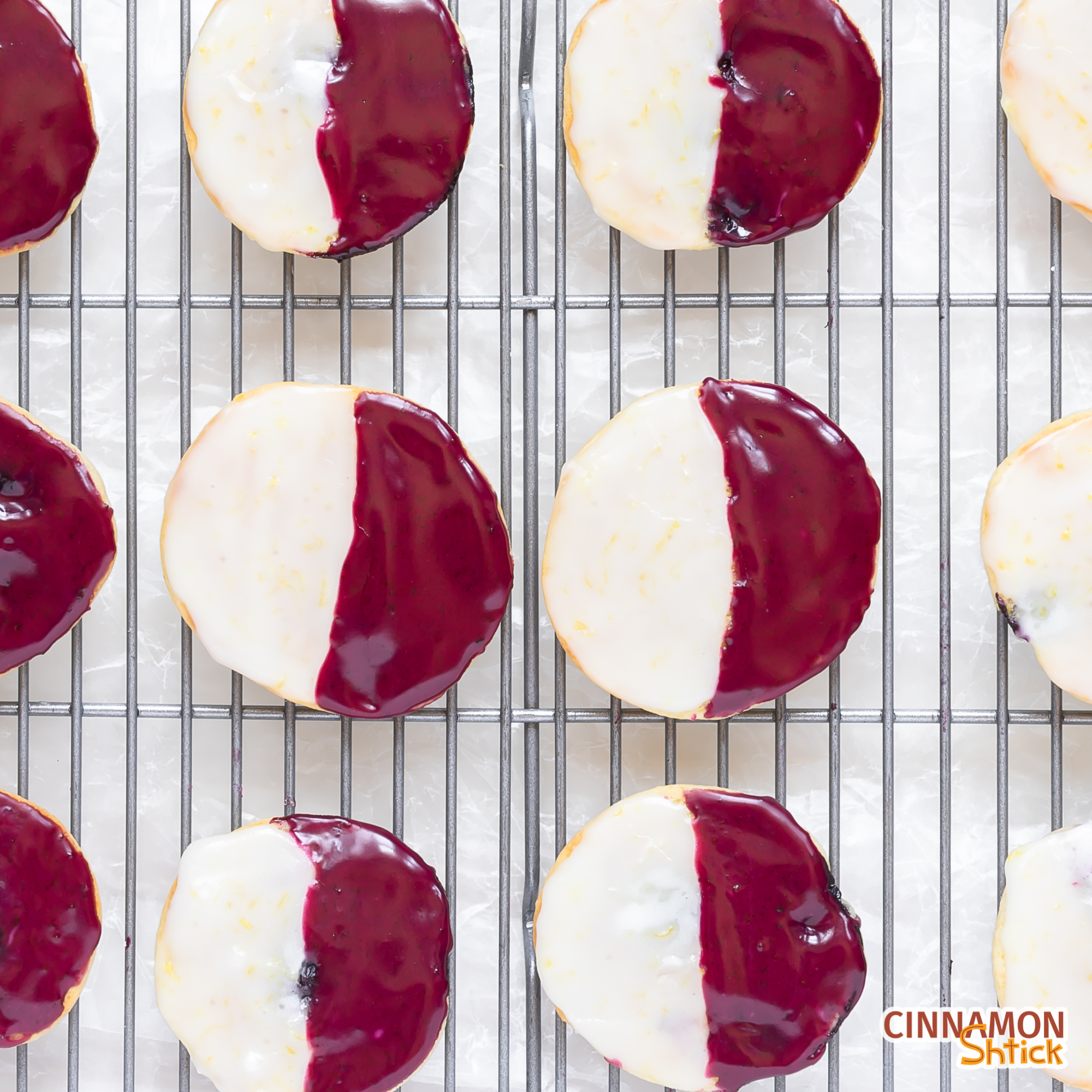
History of Black and White Cookies
I know, I know, we are not in school here. But I think it’s important to know where Black and White Cookies originated. In the early 1900s (like, 1902), Bavarian immigrants opened Glaser’s Bake Shop in the Upper East Side in New York City. It is believed that the Black and White Cookie originated at Glaser’s. Sadly, in 2018, Glaser’s closed. (Seriously, I was really, really sad! I was living in the neighborhood at the time.) Fortunately, many a Glaser’s Black and White Cookie passed my lips in the years that I lived in the Upper East Side.
According to Wikipedia, the concept of a frosting on the Black and White Cookie emerged a little more than 20 years later in Utica, New York. Listen, whatever rivalry existed between the variation in cookie topping, I have no complaints! Both forms are delish.
What is Poured Fondant?
I mention above how Glaser’s (and most bakeries) use poured fondant on their Black and White Cookies. Poured Fondant is not the fondant used to cover cakes. The fondant on cakes is called rolled fondant — because you literally need to roll it out to use it to cover a cake. Rolled fondant is also a great medium to sculpt decorations for a cake.
Poured fondant, when heated properly, is poured over desserts, such as petit fours, to give a glossy, sweet finish. It is also used to top eclairs and napoleons (mille-feuille). American bakeries also use poured fondant to ice donuts. Using poured fondant is an easy way to get a glossy, delish finish to any pastry, and it is easy to flavor it with chocolate, coffee and other flavors.
Why Doesn’t this Blemon Halfsie Recipe use Poured Fondant?
A few years ago when I was in culinary school, I searched far and wide for poured fondant. I could not find it anywhere. I could buy it online, but only in bulk in 50 pound containers. While poured fondant will last for years (if not longer) without going bad, I had no need for 50 pounds, let alone any place to store it! There are recipes to make poured fondant, but it can be a bit finicky to make. In Europe, one can buy a sensibly smaller size of poured fondant. I have no idea why it was so difficult to find in the USA.
I just recently learned that one company, Edde, is selling a smaller tub of poured fondant. Hallelujah! I am going to have to buy some and play with it. I would love to make this Blemon Halfsie recipe with it!
In place of poured fondant, most home recipes for Black and White Cookies include an icing recipe made with confectioner’s sugar. It’s a very nice substitute for poured fondant, and certainly much easier than making a batch of poured fondant.
Once I get my hands on some poured fondant, I will update this recipe to include it as an optional icing.
How this Recipe Came About
Before we get to the name, let’s talk about the foundation for this recipe. Having long been a fan of Black and White Cookies, I have sampled many, many of them. However, I had never made them. (Weird, huh?) I knew that Melissa Clark had a recipe in the New York Times that had great reviews, and some of my favorite recipe bloggers have recipes as well.
During the pandemic, I took a Zoom Black and White Cookie making class, mostly because I had nothing else to do on a Saturday afternoon during a lockdown! I will not name names, but that class was sort of silly. The chef instructor is known and certainly a fabulous baker and cook. However, he did not know how to teach an online, live, virtual class. Anyway, it turned out that the recipe we made was Melissa Clark’s recipe from the New York Times! So, it was sort of a win since I had wanted to make that recipe for so long.
Those Black and White Cookies are really delish. The cookie part is ideal in my opinion — not at all dry, like a small piece of cake. I made them several more times, and they were a hit with everyone. I then decided that I needed to vary the flavor profile. That’s when I came up with the concept for blueberry lemon black and white cookies. That was back in the winter though, and I wanted to use fresh, ripe blueberries. So, I waited until now to develop this recipe, which is adapted from Melissa Clark’s fabulous recipe.
The Origin of Blemon Halfsies
Once I developed the recipe, I was torn as to what to call these cookies. Blueberry Lemon Black and White Cookies? But there is no black and white. Blemon Cookies? Fun twist, especially given the entertainment world’s love for combining names of famous people dating (who always break up), such as Brangelina. Halfsies? Also a fun twist, especially since it brings in the history of some versions being called Half Moon Cookies. Hmmmmmm.
So, I did what any food blogger would do — I asked my Instagram followers whether these blueberry lemon black and white cookies should be called Blemons or Halfsies. It was a close race! In the end, 53% chose Blemons, and 47% chose Halfsies.

However, one of my friends sent me a message that she liked both names and couldn’t choose. She then suggested using both names. Um, I freakin’ loved it! As she said, as I come up with future flavors, I can combine the names of those flavors (a la Brangelina), and use Halfsies following the combined flavor profile name. Love.
Hence, Blemon Halfsies was born.
Making Blemon Halfsies is Easy and Fun!
These are really simple to make and can be made within an hour. Let’s break it down:
1. Whisk the Dry Ingredients
In a small bowl, whisk together the flour, baking soda, baking powder and salt.
2. Whisk the Liquid Ingredients
In another small bowl, whisk (use the same whisk) together the sour cream, milk, vanilla extract and lemon juice.
3. Cream the Butter and Sugar, and Beat in Eggs
In the bowl of an electric mixer (or a mixing bowl you use with a hand mixer), press the lemon zest into the sugar. This helps release the oils from the lemon zest, deepening the lemon flavor in the cookies. Then dump in the butter, creaming it into the sugar until the mixture is pale, light and fluffy. Beat in one egg at a time, until fully combined. The mixture will be light and fluffy.
4. Mix in the Dry and Liquid Ingredients Alternately with the Sour Cream Mixture
Add approximately one-third of the dry ingredients and mix until almost combined. Then add in half the sour cream mixture, again until almost combined. Add half the remaining flour mixture, mixing until almost combined. Then the rest of the sour cream mixture, and finish with the remaining flour mixture. Mix just until the flour is fully absorbed. Do not over mix. With a rubber spatula, fold in the blueberries. The batter will be more cake-like, wet and sticky. You will not be able to shape it by hand.
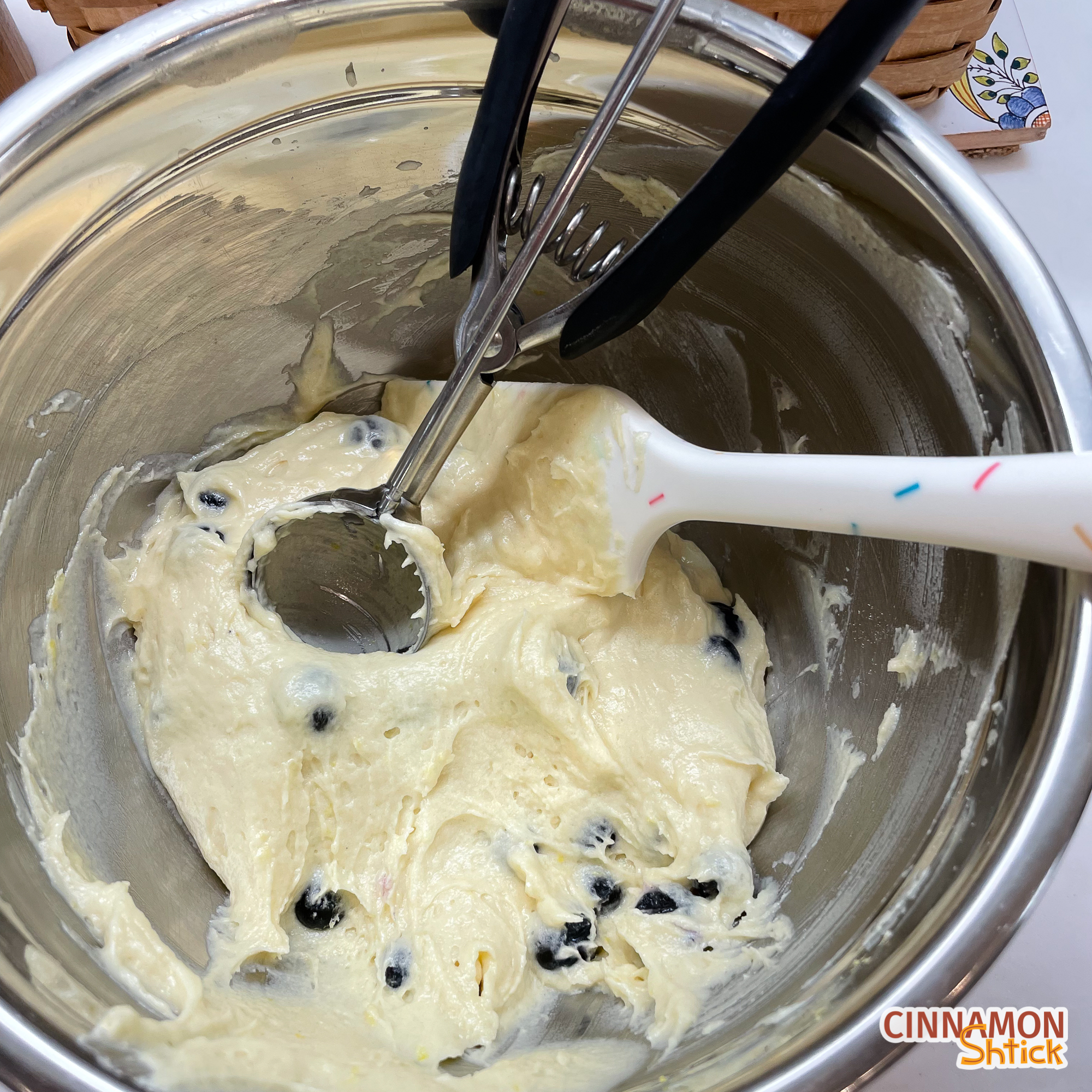
5. Scoop and Bake
I recommend using a medium size cookie scoop (1½ Tablespoons) to scoop out the batter. You can use a rounded Tablespoon for slightly smaller cookies, or ¼ cup measuring spoon for larger cookies. Scoop the batter onto baking sheets lined with parchment paper, at least a couple inches apart. (The cookies will spread a bit when baked.) I like to bake them for 6 minutes, then rotate the pan and bake an additional 4 minutes. My oven does not bake entirely evenly, so rotating the pan helps ensure a more even bake. When done baking, the cookies will not brown on top and will look almost slightly under-baked in the middles. The edges may be slightly browned. They will continue to bake on the pan from the residual heat once you remove them from the oven. Allow to cool on the pan at least 5 minutes.

6. Make the Glazes
While the cookies are baking, make the Blueberry Paste. (You can make it while the first batch are in the oven.) Be sure to cook it down a bit so that it is slightly thick (it will thicken quickly as it cools) and is dark purple in color. Once cooked, immediately push it through a strainer. Allow it to cool while you bake the rest of the cookies.
To make the glazes, use a spoon to combine the confectioner’s sugar, boiling water, light corn syrup and salt. It will be very thick, but resist the urge to add more water at this point. Pour a little less than half the glaze into a small bowl and set aside. In the original bowl, add the lemon juice and lemon zest. The lemon juice should make the consistency smooth enough to be able to spread. If it’s too thick, add 1 teaspoon of boiling water. If it’s too thin, add a little more confectioner’s sugar.
In the other bowl, add all of the blueberry paste, mixing well to combine. If it is too thick or too thin, add boiling water or confectioner’s sugar as described in the above paragraph.
7. Assemble the Blemon Halfsies
Once the cookies are cool, flip them all over so that the flat sides are on top. Use a metal spatula or the back of a spoon to coat half of each cookie with the lemon glaze. Then coat the other halves with the blueberry glaze. The glazes should set fully within 30 minutes.

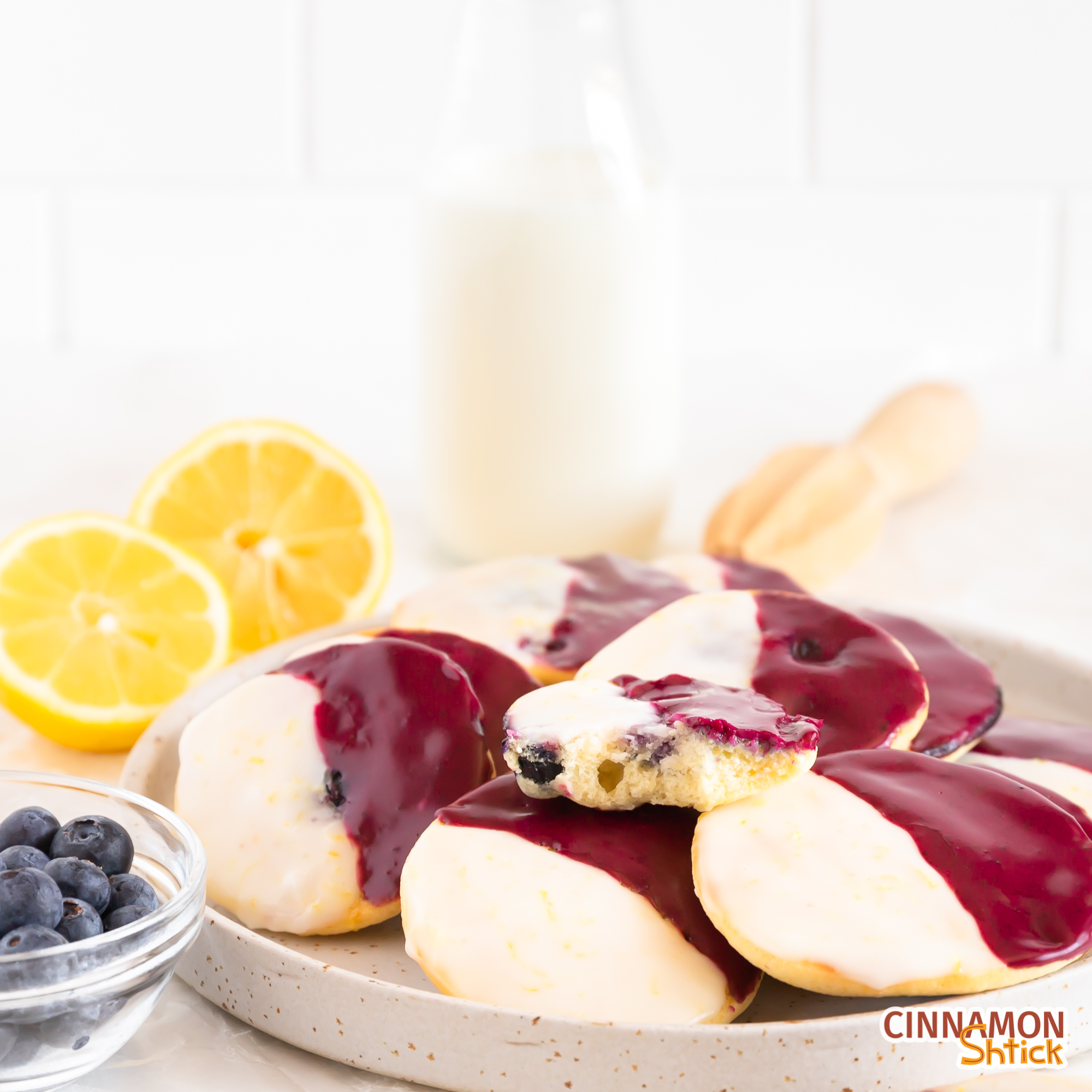
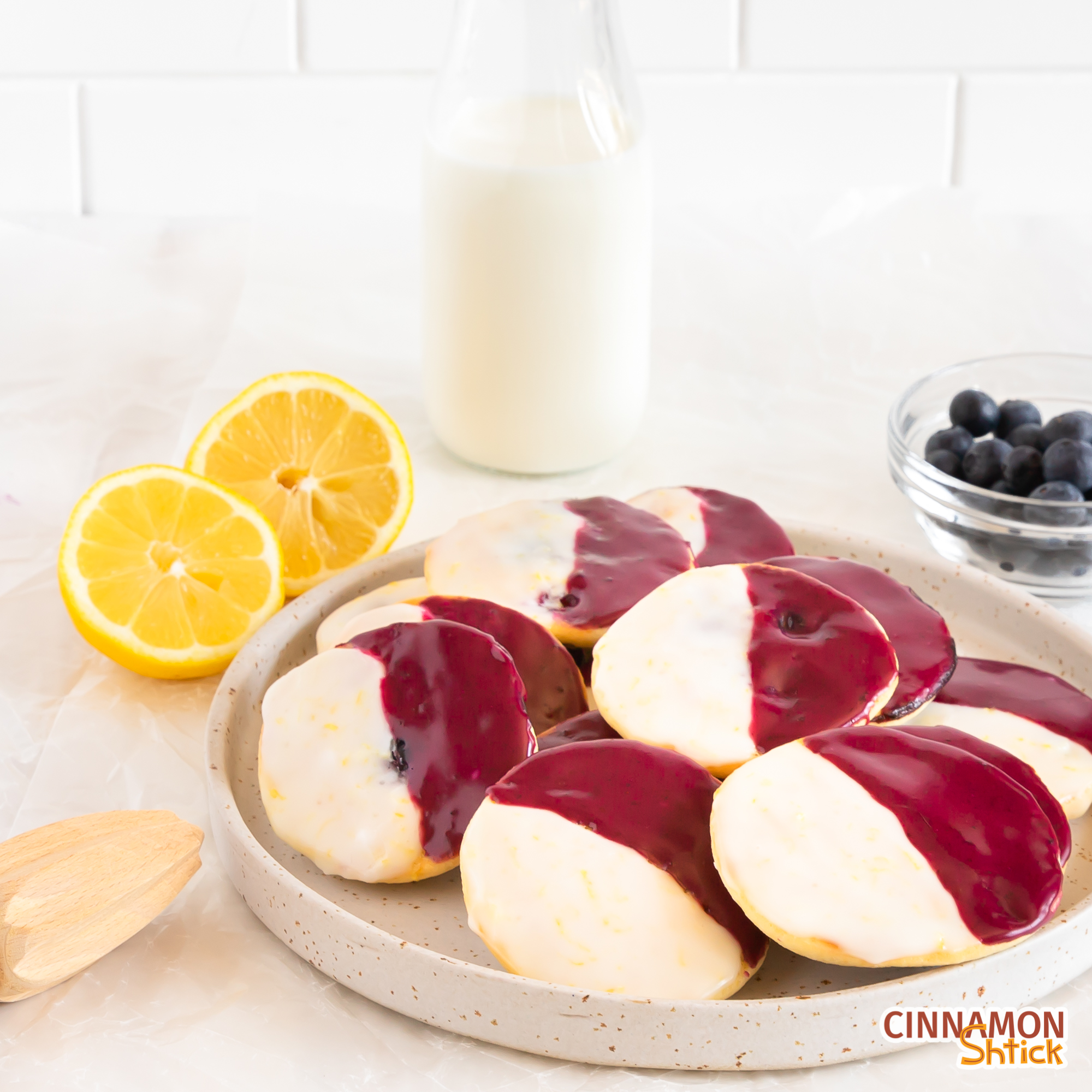
Blemon Halfsies
Equipment
- Medium Cookie Scoop
Ingredients
Lemon Blueberry Cookies:
- 255 grams all purpose flour (2 cups plus 2 Tablespoons)
- ¼ teaspoon baking soda
- 1 teaspoon baking powder
- ½ teaspoon fine sea salt
- 80 grams sour cream, at room temperature (⅓ cup)
- 80 grams whole milk, at room temperature (⅓ cup)
- 1 teaspoon vanilla extract
- 2 teaspoon lemon juice
- 2 teaspoon finely grated lemon zest
- 200 grams sugar (1 cup)
- 113 grams unsalted butter, at room temperature (½ cup or 1 stick or 8 Tablespoons)
- 2 large eggs, at room temperature
- 1 cup blueberries, washed and patted dry
Glazes:
- 300 grams confectioner's sugar (2½ cups)
- 1 Tablespoon boiling water (plus more as needed)
- 1½ Tablespoon light corn syrup
- Pinch fine sea salt
- 2 teaspoon lemon juice
- 1 teaspoon lemon zest
- Blueberry paste
Instructions
- Preheat oven to 375° F. Line baking sheets with parchment paper.
- In a small bowl, whisk together the flour, baking soda, baking powder, and sea salt. Set aside.
- In another small bowl, whisk together the sour cream, milk, vanilla, and lemon juice. Set aside.
- In the bowl of an electric mixer, press the lemon zest into the sugar with your fingertips. Using the paddle attachment of a stand mixer, add the butter and cream until light and fluffy, 2-4 minutes. Beat in the eggs, one at a time, until fully incorporated, and the mixture continues to be light and fluffy. You may have to stop the mixer once or twice to scrape down the sides of the bowl.
- Turn the mixer off and add a third of the flour mixture. Turn the mixer back on low. Before the dry ingredients fully disappear, add half of the sour cream mixture. Repeat with another third of the flour, the rest of the sour cream mixture, and the rest of the flour. You are done mixing once you can no longer see any of the flour. Do not overmix. With a rubber spatula, fold in the blueberries.
- Use a medium cookie scoop to scoop the batter onto the prepared baking sheets, spacing them at least 2 inches apart. (You can bake two sheets at a time on different shelves, rotating them and exchanging them on the shelves in the oven half way through. Or you can bake one sheet at a time. The dough can remain at room temperature in the mixing bowl until you have scooped and baked them all.) Bake for 6 minutes, rotate the sheets, and bake an additional 4 minutes. The cookies will not brown on top, will look almost uncooked in the middle, and be just slightly browned on the bottom. They will continue to firm up while cooling.
- Transfer baking sheets to wire racks and let cool for 5-10 minutes, then transfer the cookies directly to the wire racks to cool completely while you make the glazes.
- Glazes. Place the confectioner’s sugar in a medium bowl. Add the corn syrup and salt. Whisk in 1 Tablespoon of boiling water. The consistency will seem too thick. Pour a little less than half the glaze into another bowl. Into the original bowl (with more glaze), add the lemon juice and lemon zest, whisking until fully combined. If it is too thick, add 1 teaspoon of boiling water at a time until it is a thick but spreadable consistency. In the other bowl, whisk in all of the blueberry paste. If the blueberry icing is too thick, whisk in an additional 1 teaspoon of boiling water as necessary for a thick, spreadable consistency.
- Assembly. Flip each cookie over. Using a spoon or a spatula, spread the lemon glaze over half of each cookie. Then spread the blueberry glaze over the other half of each cookie. Place on wire rack until the glazes are fully set.
Notes
- As with all my recipes, I strongly encourage you to weigh your ingredients rather than measure them. Weighing the ingredients for this recipe, especially for the glaze, will get you closer to the desired result. To understand this better, see my post Weighing vs. Measuring.
- You can use an electric stand mixer or a hand mixer for this recipe.
- Be sure to pat the blueberries dry with a paper towel after washing them to avoid introducing additional liquid into the batter when you fold in the blueberries.
- If you make larger cookies by scooping out ¼ cup size cookies, increase the bake time by 2-4 minutes.
- You can make the Blueberry Glaze in advance. Store it in the refrigerator. Take it out so it can get it to room temperature when you first start gathering the ingredients for the cookies.
- Once the glazes have set, store the cookies in an airtight container where they will stay fresh at cool room temperature for several days. They also freeze beautifully. I suggest placing them on a tray in the freezer for 30 minutes to ensure that they glazes are fully hardened before stacking them on top of each other (use parchment paper between the layers) in an airtight container or Ziplock bag.
Nutrition
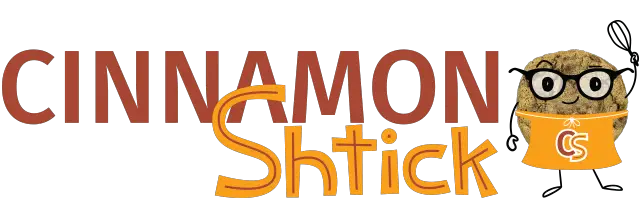
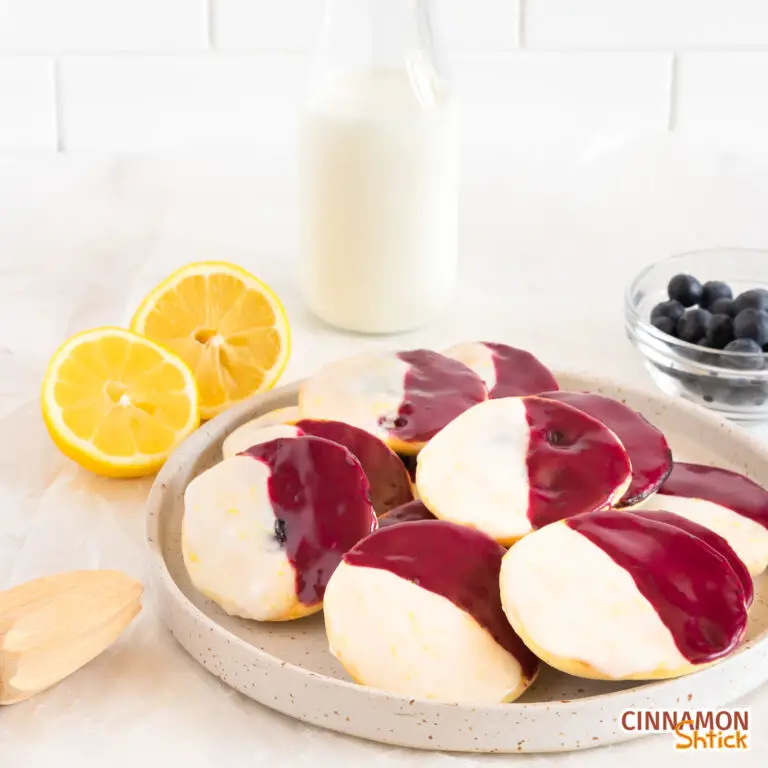
14 Comments
Can’t see the recipes; SOS
Huge apologies! My site is partially down. We are looking into it. So sorry for the inconvenience!
These came out delicious! However, I messed something up and made the blueberry paste too thin- like a sauce. Might have put too little glaze into the blueberry bowl or maybe I shouldn’t have strained out the chunks of blueberries? Still, they came out delicious!
I’m so glad you like them! For the paste, it sounds like it just needed to cook for a couple more minutes to reduce more of the water content. Stir constantly as you cook it down. I strain it to have a smooth icing, but you could certainly include the blueberry chunks.
Loving this unique recipe, the lemon and blueberry glaze is so good!
I love this flavor combination and new take on an old favorite. Wonderful!
Very good!
This looks delicious love to try it. sure my kids will love this cookies
I love the blueberry lemon combo! Yum!
Oh my gosh, these are so good! Great recipe!
It is also interesting to know about where these cookies originate.
Great recipe!!
What is blueberry paste? I can’t find instructions to make it in the recipe
My apologies. The link in the recipe somehow disappeared. (There is also a link in the text above, in the post.) I just corrected it so that the words “Blueberry paste” link to the recipe. Thanks for pointing this out!